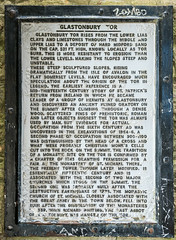St Patrick
Commemorated on 1 plaque
Glastonbury Tor Glastonbury Tor rises from the lower lias clays and limestones through the middle and upper lias to a deposit of hard Midford sand on the cap. 521 ft. high. Known locally as Tor Burr. This is more resistant to erosion than the lower levels. Making the slopes steep and unstable. These steep sculptured slopes, rising dramatically from the Isle of Avalon in the flat Somerset levels, have encouraged much speculation about the origin of the Tor in legend. The earliest reference is a mid-thirteenth century story of St.Patrick's return from Ireland in which he became leader of a group of hermits at Glastonbury and discovered an ancient ruined oratory on the summit after climbing through a dense wood. Scattered finds of prehistoric, roman and later objects suggest the Tor was always used by man, but evidence for actual occupation from the sixth century AD was uncovered in the excavations of 1964-6. A second phase of occupation between 900-1100 was distinguished by the head of a cross and what were probably Christian monk's cells cut into the rock on the summit. The tradition of a monastic site on the Tor is confirmed by a charter of 1243 granting permission for a fair at the monastery of St. Michael there. The present tower though later modified, is essentially fifteenth century and is associated with the second of two major churches which stood on the summit. The second one was probably built after the destructive eartthquake of 1275. The monastic church of St. Michael, closely associated with the great abbey in the town below, fell into ruin after the dissolution of the monasteries in 1539, when Richard Whiting, the last abbot of Glastonbury, was hanged on the Tor.
Glastonbury Tor, Glastonbury, United Kingdom where they was

_-_stained_glass,_Saint_Patrick_-_detail.jpg?width=250)
